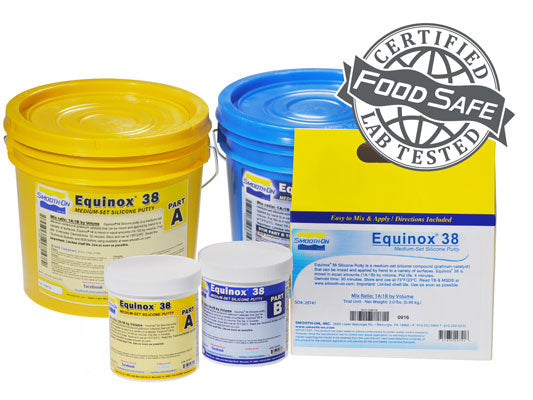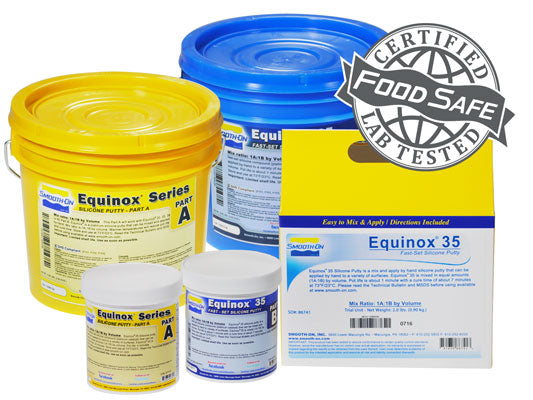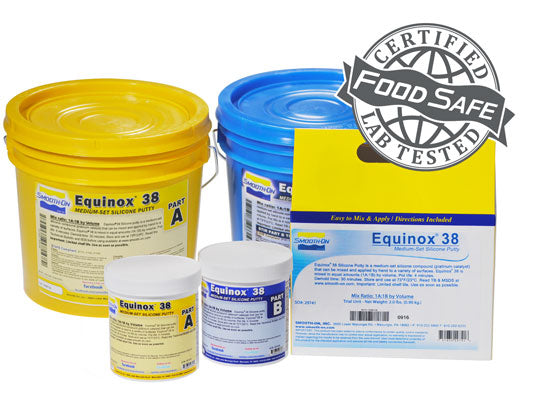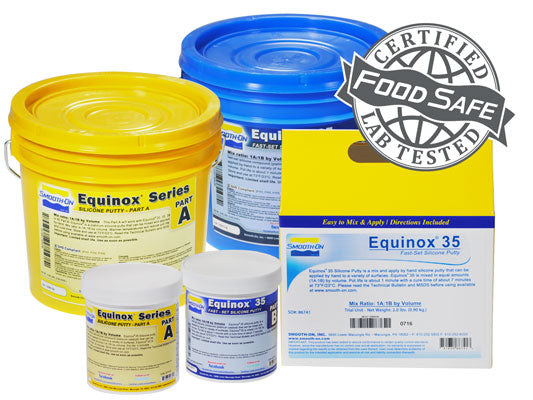Equinox™ Silicone Putty Products are new silicone compounds (platinum catalyst) that can be easily mixed and applied by hand to a variety of surfaces. Equinox™ Putty is mixed in equal amounts (1A:1B) by volume.
Features
Equinox™ 38 has a pot life of 4 minutes with a cure time of 30 minutes. Shrinkage is low and cured rubber is exceptionally strong (very high tensile strength), durable and will resist high temperatures (for casting low-temperature melt metal alloys). They also resist cure inhibition. Equinox™ Silicones are also FOOD SAFE and can be used for culinary applications.
Equinox™ 35 has a pot life of about 1 minute with a cure time of about 7 minutes at room temperature (73°F/23°C). Shrinkage is low and cured rubber is exceptionally strong (very high tensile strength), durable and will resist high temperatures (for casting low-temperature melt metal alloys). They also resist cure inhibition. Equinox™ Silicones are also FOOD SAFE and can be used for culinary applications.
Applications include making fast mould impressions from almost any surface, orthotics / orthopaedic, equine hoof repair, jewellery making and more.
Applications include making fast mould impressions from almost any surface, orthotics / orthopaedic, equine hoof repair, jewellery making and more.
Instructions
Safety – Use in a properly ventilated area (“room size” ventilation). Wear safety glasses, long sleeves and rubber gloves to minimize contamination risk. Wear vinyl gloves only. Latex gloves will inhibit the cure of the rubber.
Store and use material at room temperature (73°F/23°C). Warmer temperatures will drastically reduce working time and cure time. Storing material at warmer temperatures will also reduce the usable shelf life of unused material. These products have a limited shelf life and should be used as soon as possible.
Cure Inhibition – Addition-cure silicone rubber may be inhibited by certain contaminants in or on the pattern to be moulded resulting in tackiness at the pattern interface or a total lack of cure throughout the mould. Latex, tin-cure silicone, sulphur clays, certain wood surfaces, newly cast polyester, epoxy or urethane rubber may cause inhibition. If compatibility between the rubber and the surface is a concern, a small-scale test is recommended. Apply a small amount of rubber onto a non-critical area of the pattern. Inhibition has occurred if the rubber is gummy or uncured after the recommended cure time has passed.
Because no two applications are quite the same, a small test application to determine suitability for your project is recommended if performance of this material is in question.
To prevent inhibition, one or more coatings of a clear acrylic lacquer applied to the model surface is usually effective. Allow any sealer to thoroughly dry before applying rubber. Note: Even with a sealer, platinum silicones will not work with modelling clays containing heavy amounts of sulphur. Do a small scale test for compatibility before using on your project.
APPLYING A RELEASE AGENT - Although not usually necessary, a release agent will make demoulding easier when pouring into or over most surfaces. Ease Release™ 200 is a proven release agent for making moulds with silicone rubber. Mann Ease Release™ products are available from Smooth-On or your Smooth-On distributor.
IMPORTANT: To ensure thorough coverage, lightly brush the release agent with a soft brush over all surfaces of the model. Follow with a light mist coating and let the release agent dry for 30 minutes.
If there is any question about the effectiveness of a sealer/release agent combination, a small-scale test should be made on an identical surface for trial.
This product is mixed by hand. If you choose to wear gloves, wear vinyl gloves only. Latex gloves will inhibit the cure of the rubber.
Measuring - Equinox™ Series Putty comes as two parts. Dispense equal amounts (golf ball size, for example) of Part A and Part B. These products have a limited shelf life and should be used as soon as possible.
Mixing - Knead parts together aggressively to a uniform colour and apply quickly.
Applying - Putty can be applied directly to almost any model surface (see preparation above).
Curing - Allow the rubber to cure at room temperature (73°F/23°C) before removing from model surface. Applying heat (heat gun, hair dryer, heat lamp, etc.) will cause the rubber to cure faster. Because no two applications are quite the same, a small test application to determine suitability for your project is recommended if performance of this material is in question.
Applying a Support Shell - Usually, Putty moulds will be too thin to support themselves during casting. A support shell made of Plasti-Paste II™ or Matrix™ NEO™ and chopped fibre can be applied over the mould surface.
Post Curing - Do not cure rubber where temperature is less than 65°F/18°C. Optional: Post curing the mould will aid in quickly attaining maximum physical and performance properties. After curing at room temperature, expose the rubber to 176°F/80°C for 2 hours and 212°F/100°C for one hour. Allow mould to cool to room temperature before using.
Using The Mould - When first cast, silicone rubber moulds exhibit natural release characteristics. Depending on what is being cast into the mould, mould lubricity may be depleted over time and parts will begin to stick. No release agent is necessary when casting wax or gypsum. Applying a release agent such as Ease Release™ 200 (available from Smooth-On) prior to casting polyurethane, polyester and epoxy resins is recommended to prevent mould degradation.
Mould Performance & Storage - The physical life of the mould depends on how you use it (materials cast, frequency, etc.). Casting abrasive materials such as concrete can quickly erode mould detail, while casting non-abrasive materials (wax) will not affect mould detail. Before storing, the mould should be cleaned with a soap solution and wiped fully dry. Two part (or more) moulds should be assembled. Moulds should be stored on a level surface in a cool, dry environment.





